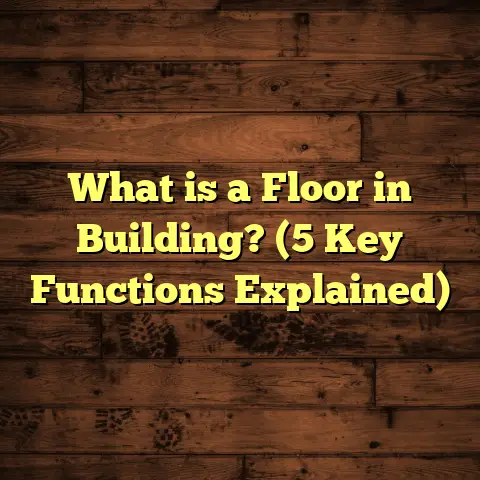What is Floor Stripping? (5 Essential Benefits for Clean Floors)
Sustainability has become a big part of how I approach every flooring project. When I first started in this business years ago, my primary focus was just on fixing floors and making them look good. But over time, I realized that the choices we make about cleaning and maintenance have a huge impact on the environment. That’s why I want to talk about floor stripping—a method that’s not just about cleaning but about preserving floors, saving money, and reducing waste. If you care about extending the life of your floors and keeping your home or business greener, floor stripping is an essential step.
What is Floor Stripping?
Floor stripping is the process of removing old layers of wax, sealers, finishes, and embedded dirt from hard surface floors. It’s something I often compare to hitting a reset button for your floors. Over time, floors get covered with layers of buildup that regular cleaning can’t remove. This buildup dulls the floor’s appearance and traps dirt, making your routine cleaning less effective.
When I strip a floor, I use special chemical strippers designed to break down these old layers so they can be wiped or scrubbed away. This leaves the floor clean and ready for a fresh coat of wax or finish. Unlike mopping or sweeping, stripping gets rid of the residue beneath the surface.
You might ask: “Why should I bother with stripping? Doesn’t regular cleaning work?” From my experience, stripping is the difference between a floor that looks tired and worn out and one that shines like new for years. Floors aren’t just surfaces to walk on—they’re investments. Taking care of them properly means they last longer and look better, saving you money and reducing waste.
How I Discovered the Power of Floor Stripping
Let me share a story from early in my career that shaped how I view floor care today. A local school called me because their gym floor looked awful despite daily cleaning. They were even considering replacing it since it seemed permanently dull and dirty.
I suggested stripping before they made that big investment. After applying the chemical stripper and scrubbing off years of wax and dirt buildup, the gym floor looked almost brand new. The school saved thousands on replacement costs, and the floor’s life extended by many years.
That experience taught me something valuable: sometimes cleaning isn’t enough—the floor needs starting fresh with stripping. And that approach supports sustainability by reducing waste and unnecessary material use.
5 Essential Benefits of Floor Stripping for Clean Floors
1. Restores Floor Appearance and Shine
Have you ever cleaned your floor only to find it still looks dull or cloudy? That’s usually due to layers of wax buildup and embedded dirt blocking light reflection.
Stripping removes all those old layers and reveals the original surface underneath. This gives your floor its natural shine back.
In one office lobby project, I used a gloss meter before and after stripping. The reflectivity increased by over 60%. That kind of shine just can’t be achieved by regular mopping or buffing alone.
Another time, a restaurant hired me because their vinyl floors looked sticky and unattractive despite daily cleaning. After stripping and refinishing, customers complimented the welcoming look immediately.
Stripping brings life back to floors that seem beyond hope.
2. Enhances Hygiene by Removing Trapped Dirt and Germs
Over time, dirt, bacteria, and allergens get trapped in layers on your floor’s surface—especially in homes with pets or busy commercial places.
Regular mopping often just moves these contaminants around rather than removing them completely.
When I strip floors for healthcare facilities or schools, they notice a big difference in cleanliness because stripping removes these hidden germs.
A study by the International Sanitary Supply Association showed microbial contamination dropped by up to 90% after thorough stripping and refinishing.
For families with kids or pets prone to allergies, this level of cleanliness can make a real difference in indoor air quality and health.
3. Prolongs Floor Life and Reduces Replacement Costs
One thing I always emphasize to clients: flooring is an investment.
Replacing floors too soon wastes resources and money. Stripping removes damaged finish layers and prepares the floor for a fresh protective coat, helping it last much longer.
Manufacturers report that floors maintained with regular stripping and waxing last up to 40% longer than those cleaned with standard methods alone.
I’ve seen clients who kept up with scheduled stripping avoid costly replacements for years beyond original expectations.
This saves hundreds or thousands of dollars in the long run—not to mention reducing landfill waste from old flooring materials.
4. Improves Safety by Preventing Slips and Falls
Old wax buildup can create slippery surfaces or uneven traction that increase fall risks.
In places like schools, hospitals, or restaurants where safety is critical, slipping accidents are common if floors aren’t maintained properly.
By stripping away these hazardous layers, you get a consistent finish that reduces slipping hazards while still looking great.
I’ve worked with daycare centers where accident reports dropped noticeably after introducing regular floor stripping into their maintenance routine.
5. Supports Sustainability by Reducing Waste and Chemical Use
You might not realize it, but properly stripping floors helps the environment in several ways:
- Delays Flooring Replacement: Keeping floors in good condition longer means fewer materials end up in landfills.
- Eco-Friendly Products: Using modern green-certified stripping chemicals reduces harmful chemical runoff.
- Proper Waste Disposal: Handling old finish residue responsibly prevents environmental damage.
One commercial client switched from harsh solvents to eco-friendly products after consulting with me. They cut hazardous chemical waste by 70% annually while maintaining clean floors.
That balance between maintenance and sustainability is something I always promote—helping clients do right by their floors and the planet at the same time.
How I Perform Floor Stripping: Step-by-Step Tips
If you want to try floor stripping yourself or understand what professionals do during the process, here’s a detailed guide based on years of hands-on experience:
Step 1: Choose the Right Stripper for Your Floor Type
Not all floors are created equal—vinyl, tile, hardwood, or concrete all require different care.
Using the wrong chemical stripper can damage sensitive surfaces like hardwood or engineered wood.
I always recommend checking product labels carefully or consulting a flooring expert before starting.
For example:
- Vinyl floors often use alkaline-based strippers.
- Hardwood requires gentler formulas specifically designed not to harm wood fibers.
- Concrete can handle stronger acid-based strippers but needs neutralizing afterward.
Step 2: Prepare Your Space Thoroughly
Remove all furniture, mats, rugs, or anything that could obstruct access or get damaged during stripping.
Sweep or vacuum loose dirt to avoid scratching during scrubbing.
Ventilate well if using chemical strippers indoors; open windows or use fans for airflow.
Step 3: Apply Stripper Evenly
Use a mop, sprayer, or applicator designed for your product type.
Apply an even coat across the entire floor surface.
Let it sit for the recommended time—usually between 10-15 minutes but no longer than instructions specify.
This dwell time allows the stripper to break down old wax and finish layers effectively.
Step 4: Scrub Thoroughly to Remove Buildup
Use a rotary floor machine with scrubbing pads for large areas; hand brushes work for small spots or corners.
Move methodically across the floor until all old layers are loosened.
This step requires some elbow grease but is crucial for complete removal.
Step 5: Rinse Multiple Times
Rinsing is often overlooked but critical—it removes all stripper residue which can interfere with new finishes adhering properly.
I typically rinse at least twice with clean water, sometimes three times depending on how dirty the floor was initially.
Use wet vacuums or squeegees to remove rinse water quickly between rinses.
Step 6: Dry Completely Before Applying Finish
Allow floors to dry fully—this might take several hours depending on ventilation conditions.
Never apply wax or finish over damp surfaces as it leads to peeling or bubbling later on.
Use fans or dehumidifiers if needed to speed up drying in humid climates.
Step 7: Apply New Protective Finish
Choose high-quality waxes or sealants suited for your flooring type and environment (commercial vs residential).
Follow manufacturer instructions carefully for application methods and drying times.
Multiple thin coats usually work better than one thick layer for durability and appearance.
Personal Reflections: Lessons Learned Over Time
One mistake early in my career taught me a lot about floor stripping’s importance—especially rinsing properly. On a hardwood project, I skipped one rinse thinking it wouldn’t matter much. Within weeks, the new finish started peeling badly. The client was understandably upset, but it was a clear lesson for me: every step matters.
Since then, I never rush rinsing or drying phases no matter how tight schedules get.
Also, I’ve learned that communication with clients about what to expect post-stripping helps avoid frustration. Floors often look dull right after stripping before finishes go on—and some odors linger briefly from chemicals used. Explaining this upfront builds trust and satisfaction later on when results shine through.
Data That Supports Floor Stripping Benefits
Here’s some research and statistics backing what I’ve observed:
- Microbial Reduction: The International Sanitary Supply Association found that thorough stripping reduces microbial contamination on floors by up to 90%, which improves hygiene significantly.
- Cost Savings: A survey of commercial buildings by Facility Services Journal revealed those using scheduled stripping programs had 25% lower annual maintenance costs compared to buildings relying only on basic cleaning.
- Floor Longevity: Manufacturer studies show regular stripping extends protective finish life by 30-40%, translating into fewer premature flooring replacements.
- Safety Improvements: OSHA reports slip-and-fall incidents drop by an average of 15% in facilities adopting proper floor maintenance including stripping and refinishing.
These numbers reinforce how floor stripping is more than cosmetic—it impacts health, safety, budgets, and sustainability directly.
Real Client Stories: Flooring Transformations Through Stripping
Community Center Vinyl Floor Rescue
A community center contacted me about their vinyl floors looking stained and scratched beyond repair. They were planning a full replacement costing over $20,000—a huge budget hit for their nonprofit organization.
Instead, we stripped their floors thoroughly using eco-friendly products recommended for vinyl surfaces. Then we applied multiple coats of durable protective finish designed for heavy foot traffic areas.
The result? Floors looked brand new at a fraction of replacement cost—only about $3,500 including labor and materials.
The center staff reported happier visitors commenting on how clean the space felt plus easier ongoing maintenance since dirt no longer embedded in old wax layers.
They delayed expensive replacement plans by at least seven years thanks to proper care starting with stripping.
School Gym Floor Restoration
Another memorable project was at a local school gym where years of daily use left hardwood floors looking dull despite frequent cleaning.
We stripped off thick old wax layers carefully using gentle hardwood-safe products followed by sanding minor scuffs before refinishing with high-quality polyurethane sealant.
Not only did the gym floor regain its original shine but also became safer with improved traction reducing slip risk during sports activities.
The school extended its flooring warranty period by three years after adopting regular maintenance including annual stripping cycles recommended by me.
Restaurant Kitchen Safety Upgrade
A restaurant owner worried about staff slipping incidents called me after noticing sticky patches forming despite mopping multiple times daily.
After inspection, I found excessive wax buildup combined with grease residue causing slick spots not visible at first glance.
We stripped away all old layers thoroughly then applied anti-slip finish designed specifically for commercial kitchens meeting health code requirements.
Staff reported fewer falls within weeks while kitchen looked cleaner overall—a win-win situation improving safety without costly floor replacement during busy operation hours.
Frequently Asked Questions About Floor Stripping
Q: How often should I strip my floors?
It depends on traffic levels and flooring type. High traffic commercial areas might need stripping every 6 months; residential spaces may only need it once every 1-2 years.
Q: Can I strip floors myself?
Yes! But be sure you use the right products for your floor type and follow safety instructions carefully. Test in small areas first if unsure.
Q: Are there eco-friendly strippers available?
Absolutely. Many manufacturers now offer green-certified strippers that reduce harmful chemicals without sacrificing effectiveness.
Q: Will stripping damage my hardwood floors?
If done correctly using appropriate products designed for hardwoods, no damage should occur. Avoid harsh solvents or acid-based strippers on wood surfaces.
Q: What’s the difference between stripping and deep cleaning?
Stripping removes old wax/finish layers chemically; deep cleaning mostly involves removing surface dirt physically but leaves wax intact underneath.
Final Thoughts on Floor Stripping’s Role in Clean Floors
Floor stripping isn’t just another cleaning chore—it’s a powerful maintenance step that restores beauty, improves hygiene and safety, saves money long term by extending floor life, and promotes sustainability through reducing waste and chemical use.
In my years working hands-on with various floors—from homes to schools to restaurants—I’ve seen firsthand how transformative proper stripping can be when done right. If you care about your floors looking great while doing your part for environmental responsibility, consider making floor stripping part of your routine maintenance plan.
Curious about specific products or techniques for your flooring type? Need help estimating costs? Just ask—I’m here to share what I’ve learned so you can keep your floors clean and lasting longer without guesswork or wasted effort!





